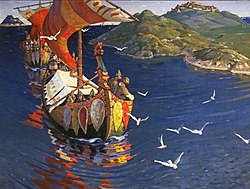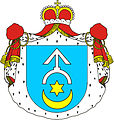Rurik: Difference between revisions
89.170.79.251 (talk) |
Nora lives (talk | contribs) →Rurikid descendants: Vladimir-Suzdal, Grand Duchy of Moscow, Tsardom of Russia |
||
| Line 81: | Line 81: | ||
==Rurikid descendants== |
==Rurikid descendants== |
||
[[Rurik dynasty]] went on to rule [[Kiev]] and its vast Empire. After the disintegration of [[Kievan Rus]] in the 13-14th centuries, the dynasty continued to rule two of the three successor states. One is [[Galicia-Volhynia]] until the deaths of [[Andrew of Galicia|Andrew]] and [[Lev II of Galicia|Lev II]] in 1323. Another being north-eastern principalities that would eventually |
[[Rurik dynasty]] went on to rule [[Kiev]] and its vast Empire. After the disintegration of [[Kievan Rus']] in the 13-14th centuries, the dynasty continued to rule two of the three successor states. One is [[Galicia-Volhynia]] until the deaths of [[Andrew of Galicia|Andrew]] and [[Lev II of Galicia|Lev II]] in 1323. Another being north-eastern principalities of [[Vladimir-Suzdal]] that would eventually become the [[Grand Duchy of Moscow]] and [[Tsardom of Russia]], the last ruler from this line being [[Fedor I]] (died 1598). |
||
One descendant of the Rurikid [[Grand Prince of Tver]] was [[Catherine the Great]], who married [[Peter III of Russia|Peter III]] of the [[Romanov dynasty]] in 1745, uniting the two dynasties. |
One descendant of the Rurikid [[Grand Prince of Tver]] was [[Catherine the Great]], who married [[Peter III of Russia|Peter III]] of the [[Romanov dynasty]] in 1745, uniting the two dynasties. |
||
Revision as of 22:31, 27 February 2010
| Rurik | |
|---|---|
| Prince of Novgorod | |
| Reign | 864-879 |
| Successor | Oleg |
| Burial | ? |
| Issue | Igor |
| Dynasty | Rurik Dynasty |

Rurik, or Riurik (Template:Lang-ru; Template:IPA-ru; Old East Norse: Rørik, meaning "famous ruler"; c. 830 – c. 879), was a Varangian chieftain who gained control of Ladoga in 862, built the Holmgard settlement near Novgorod, and founded the Rurik Dynasty which ruled Kievan Rus and then Galicia-Volhynia until the 14th and Muscovy until the 16th century.
Name

Riurik is the Slavic rendering of the same Germanic name as the modern Anglo-Scots Roderick, the Welsh Rhydderch or Spanish and Portuguese Rodrigo. In old Germanic languages it had forms such as Hrodric (Old High German) and Hroðric (Old English). In Old Norse, Hrœrekr (Norway, Iceland) and RøRikR (Denmark, Sweden), from which Riurik is derived. The name also appears in Beowulf as Hréðrík.[1]
History

There is a debate over how Rurik came to control Ladoga and Novgorod. The only information about him is contained in the 12th-century Russian Primary Chronicle, which states that Chuds, Slovene (one of the tribes of eastern Slavs), Merias, Veses and Krivichs (also a slavic tribe) "…drove the Varangians back beyond the sea, refused to pay them tribute, and set out to govern themselves". Afterwards the tribes started fighting each other and decided to invite Rurik to reestablish order.
Rurik remained in power until his death in 879. He married Efanda (Edvina Alfrind Ingrid) of Urman. His successors (the Rurik Dynasty), however, moved the capital to Kiev and founded the state of Kievan Rus, which persisted until 1240, the time of Mongol invasion. A number of extant princely families are patrilineally descended from Rurik, although the last Rurikid to rule Russia, Vasily IV, died in 1612.
There is a large 9th-century funerary barrow in Novgorod Oblast, intricately defended against looting.[clarification needed] It remains to be excavated. The local inhabitants refer to it as Rurik's Grave.
Disputed origin
Even though some historians emphasize folklore roots for the Rurik legend and consequently dismiss Rurik as a legendary figure, there is a controversy about his ethnic origins in Eastern Europe.
According to the Primary Chronicle Rurik was one of the Rus, a Varangian tribe likened by the chronicler to Danes, Swedes, Angles, and Gotlanders. In the 20th century, archaeologists partly corroborated the chronicle's version of events. It was discovered that the settlement of Ladoga, whose foundation has been ascribed to Rurik, was actually established in the mid-8th century. Earthenware, household utensils, and types of buildings from the period of Rurik's foundation correspond to patterns then prevalent in Jutland.

Some Slavic historians (B.A. Rybakov and his followers among them) argue that the account of Rurik's invitation was borrowed by a pro-Scandinavian chronicler from a hypothetical Norse document. For instance, the Primary Chronicle states that Rurik arrived to Slavic lands with two brothers, Sineus and Truvor, and sent them to rule the towns of Beloozero and Izborsk, respectively. Instead of connecting Sineus to Signjotr and Truvor to Torvald, they suggest that the chronicler read a hypothetical Scandinavian document and misinterpreted the Norse words 'sine hus' (with house) and 'tru voring' (with loyal guard) as the names of Rurik's brothers: Sineus and Truvor.
There is another theory that Rurik, on account of common intermarriages between Varangians and Slavic women, was of mixed Slavic-Varangian descent. This theory is based on the information of the first modern historian of Russia, Vasily Tatishchev (a Rurikid himself), who claimed that Rurik was of Wendish extraction. He went so far as to name his mother, Umila; his maternal grandfather, Gostomysl; and a cousin, Vadim. Rurik's father were from Finland. Those who assume good faith on Tatishchev's part point out that he based his account on the lost Ioachim Chronicle.
Last there is a theory that identifies Rurik with the Danish Viking lord Rorik of Dorestad, who ruled the western coast from Jutland down to northern France.
Genetic research
A current DNA research project by Professor Andrzej Bajor of Poland, under the auspices of the Family Tree DNA Rurikid Dynasty Project, seeks to more accurately place Rurik within the light of history and out of the shadows of legend, while simultaneously trying to find his modern descendants. This project also seeks to study the DNA of male descendants of the medieval Lithuanian ruler Gediminas (Gedymin), whose line includes some of the highest princely families of Russia and Poland. The Gediminids intermarried with the Rurikids, and there is a possibility that they may even descend from Rurik, or at least from one of his ancestors within historical times - the project seeks to answer this question. So far, only two modern Rurikid princes have agreed to take this DNA test. Their results indicate that their male line originated in Uppland province in Sweden. So far, one Swede shares 11 of the prince's markers, and he believes that his own male line goes back to the 15th century in Roslagen. The DNA results of modern Rurikid princes indicate that Rurik was of Finno-Ugrian descent (haplogroup N3a1).[2] Further genetic studies seem to indicate the existence of two haplogroups among modern Rurikids: the descendants of Vladimir II Monomakh (Monomakhoviches) are of N3a1 group typical for Finno-Ugrian people, while the descendants of Oleg I of Chernigov (Olgoviches) are of R1a group typical for Slavic peoples. According to the Russian Newsweek magazine it indicates that the official genealogy is probably incorrect but leaves the ethnic origin of Rurik unclear.[3]
Hrörek of Dorestad

The only Hrörek described in Western chronicles was Rorik of Dorestad, a konung from the royal house of Hedeby. Since the 19th century, there have been attempts to identify him with the Viking prince Rurik of Russian chronicles.[4] Alexander Nazarenko objects to this identification.[5]
Roerik of Dorestad was born about 810/820 to Ali Anulo, 9th King of Hedeby. Frankish chroniclers mention that he received lands in Friesland from the Emperor Louis I. This was not enough for him, and he started to plunder neighbouring lands: he took Dorestad in 850, captured Hedeby in 857 and looted Bremen in 859. The Emperor was enraged and stripped him of all his possessions in 860. After that Roerik disappears from the Western sources for a considerable period of time. And at that very moment, in 862, the Rurik of Rus arrives in the Eastern Baltic, builds the fortress of Ladoga and later moves to Novgorod.
Rorik of Dorestad reappeared in Frankish chronicles in 870, when his Friesland demesne was returned to him by Charles the Bald; in 882 he is already mentioned as dead. The Russian chronicle places the death of Rurik of Novgorod at 879. According to Western sources, the ruler of Friesland was converted to Christianity by the Franks. This may have parallels with the Christianization of the Rus', as reported by Patriarch Photius in 867.
Rurikid descendants
Rurik dynasty went on to rule Kiev and its vast Empire. After the disintegration of Kievan Rus' in the 13-14th centuries, the dynasty continued to rule two of the three successor states. One is Galicia-Volhynia until the deaths of Andrew and Lev II in 1323. Another being north-eastern principalities of Vladimir-Suzdal that would eventually become the Grand Duchy of Moscow and Tsardom of Russia, the last ruler from this line being Fedor I (died 1598).
One descendant of the Rurikid Grand Prince of Tver was Catherine the Great, who married Peter III of the Romanov dynasty in 1745, uniting the two dynasties.
Historian Vasily Tatishchev and filmmaker Jacques Tati were descended from Rurik, as are many noble Russian families. Among these descendants of Rurik are the Volkonsky, Obolensky, Shuyski, Dolgorukov, Khilkoff, Repnin, Gorchakov, Gagarin, Wassilchikov, and Putyatin families, as well as Ruthenian families of Ostrogski, Wareg-Massalski, and Czetwertyński.
Through the Ukrainian-born wife of the twelfth-century King Henry I of France, many Western Europeans, noble and commoner alike, can claim descent from Rurik. Henry's queen had been born Anne of Kiev, daughter of Yaroslav the Wise, probably a great-great-great-grandson of Rurik.
- Khilkoff Coat of ArmsKhilkoff Coat of Arms
- Coat of arms of the Gorchakov family
References
- ^ Volume I, Section 3, Beowulf: Scandinavian Traditions; Personality of the Hero; Origin and Antiquity of the Poem; the Religious Element. in Ward & Trent, et al. The Cambridge History of English and American Literature. New York: G.P. Putnam’s Sons, 1907–21; New York: Bartleby.com, 2000 (http://www.bartleby.com/211/0303.html).
- ^ DNA Testing of the Rurikid and Gediminid Princes
- ^ Операция «Чистые Рюрики» Russian Newsweek N52 January 2008
- ^ Rurik's identification with Hrörek was propagated by Boris Rybakov and Anatoly Kirpichnikov (see А.Н. Кирпичников: Сказание о призвании варягов. Анализ и возможности источника // Первые скандинавские чтения. - СПб., 1997. - С. 7-18).
- ^ Nazarenko A., Rjurik и Riis Th., Rorik // Lexikon des Mittelalters. VII. - Munchen, 1995. - P. 880, 1026.



